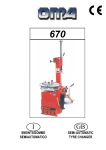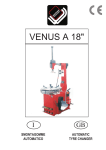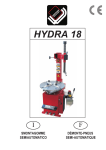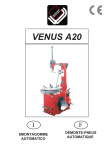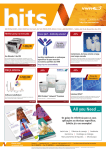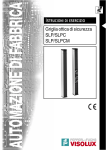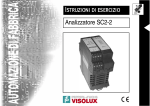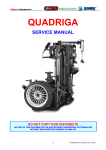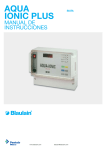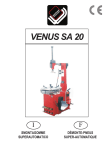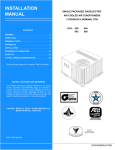Download smontagomme superautomatico super
Transcript
672HY I GB SMONTAGOMME SUPERAUTOMATICO SUPER-AUTOMATIC TYRE CHANGER Manuale di istruzioni per l’uso e la manutenzione dello Instructions and maintenance manual for SMONTAGOMME PER AUTOVETTURA CARS TYRE CHANGER Modello 672HY Model 672HY Matricola N° Serial N° Anno di costruzione Year of manufacture COSTRUTTORE: MANUFACTURER: WERTHER INTERNATIONAL S.p.A. Via F. BRUNELLESCHI, 12 42040 CADE’ (RE) - ITALY Telefono ++ / +522 / 9431 Telefax ++ / +522 / 941997 WEB http://www.wertherint.com E-mail [email protected] WERTHER INTERNATIONAL S.p.A. Via F. BRUNELLESCHI, 12 42040 CADE’ (RE) - ITALY Telefono ++ / +522 / 9431 Telefax ++ / +522 / 941997 WEB http://www.wertherint.com E-mail [email protected] 1ª Emissione 08 Luglio 2005 1rst Edition - 08 July 2005 CENTRO DI ASSISTENZA AUTORIZZATO: AUTHORISED SERVICE CENTRE: Rev.1 ...............................11/12/2006 1 Indice Contents Imballaggio, trasporto e stoccaggio Pag. 3 Packing, transport and storage Page 3 Introduzione Introduction Page 3 Pag. 3 Cap.1 Descrizione della macchina Chapter 1 Pag. 4 Chapter 2 Description of the machine Page 4 Technical specifications Page 5 Cap.2 Specifiche tecniche Pag. 5 Cap.3 Sicurezza Pag. 6 Chapter 3 Safety Page 6 Cap.4 Installazione Pag.10 Chapter 4 Installation Page 10 Cap.5 Funzionamento ed uso Pag.16 Chapter 5 Operating principles and use Page 16 Cap.6 Manutenzione Pag.20 Chapter 6 Maintenance Page 20 Cap.7 Inconvenienti e rimedi Pag.22 Chapter 7 Troubleshooting Page 22 Appendice A Appendice B Informazioni particolari Pag.23 Appendix A Special notes Page 23 Parti di ricambio Pag.23 Appendix B Spare parts Page 23 Schemi di funzionamento Pag.24 (Riservati al personale specializzato del centro di assistenza autorizzato) 2 Working schemes Page 24 (Reserved to specialised personnel from authorised service centre) IMBALLAGGIO, TRASPORTO E STOCCAGGIO PACKING, TRANSPORT AND STORAGE LE OPERAZIONI DI IMBALLAGGIO, SOLLEVAMENTO, MOVIMENTAZIONE, TRASPORTO E DISIMBALLO DEVONO ESSERE AFFIDATE ESCLUSIVAMENTE A PERSONALE CHE SIA ESPERTO IN TALI OPERAZIONI E CHE CONOSCA BENE LO SMONTAGOMME ED IL PRESENTE MANUALE ALL PACKING, LIFTING, HANDLING, TRANSPORT AND UNPACKING OPERATIONS ARE TO BE PERFORMED EXCLUSIVELY BY EXPERT PERSONNEL WITH KNOWLEDGE OF THE TYRE CHANGER AND THE CONTENTS OF THIS MANUAL IMBALLAGGIO Lo smontagomme viene inviato su pallet, ricoperto con un involucro di cartone, del peso medio di 240 Kg. PACKING The tyre changer is sent on pallets, covered with carton, weighing approximately 240 Kg. SOLLEVAMENTO E MOVIMENTAZIONE I pallet devono essere movimentati mediante carrelli elevatori. LIFTING AND HANDLING The pallets must be moved with a lift truck. I mezzi scelti devono essere idonei al sollevamento e allo spostamento in sicurezza, tenendo conto di dimensioni, peso, baricentro, sporgenze e parti delicate da non danneggiare. The equipment chosen must be suitable for safe lifting and moving, bearing in mind the dimensions, weight, barycentre, juts, and fragile parts not to be damaged. STOCCAGGIO Gli imballi devono sempre essere conservati in luoghi coperti e protetti a temperature comprese fra -10°C e +40°C. e non devono essere esposti ai raggi diretti del sole. STORAGE Packed machinery must always be kept in a covered, protected place, at a temperature between -10 °C e + 40°C, and must not be exposed to direct sunlight. IMPILAMENTO DEI PACCHI Il tipo di imballo previsto prevede la possibilità di impilare in magazzino fino a 3 imballi uno sull’altro, purchè vengano correttamente disposti ed assicurati contro la caduta. Nei cassoni dei camion o nei containers si possono impilare fino a 2 imballi, purchè vengano reggiati bene ed assicurati contro la caduta. PACKAGES STACKING. The type of packing allows the possibility of stacking up to 3 packages, provided they are restrained to prevent falling. Up to 2 pallets may be stacked one upon the other on lorries or in containers if properly positioned and provided they are restrained to prevent falling. APERTURA DEGLI IMBALLI All’arrivo verificare che la macchina non abbia subito danni durante il trasporto e che ci siano tutti i pezzi indicati nella lista di spedizio ne. Gli imballi devono essere aperti adottando tutte le precauzioni per evitare danni alle persone e ai pezzi della macchina (evitare cadute di pezzi dal pallet durante l’apertura). OPENING THE CRATES When the crates arrive, check that the machine has not been damaged during transport and that all the listed parts are present. The crates must be opened using all possible precautionary measures to avoid damaging the machine or its parts. Make sure that parts do not fall from the crate during opening. ELIMINAZIONE DELL’IMBALLO Il legno del pallet e il cartone dell’involucro possono essere riutilizzati o riciclati. DISPOSAL OF CRATES The wood of the pallets and the package carton may be re-used or recycled. INTRODUZIONE INTRODUCTION I ATTENZIONE I WARNING Questo manuale è stato scritto per il personale di officina addetto all’uso dello smontagomme (operatore) e per il tecnico addetto alla manutenzione ordinaria (manutentore) pertanto, prima di effettuare qualsiasi operazione sullo smontagomme e/o sul suo imballaggio, occorre leggere attentamente tutto il manuale, poichè esso contiene informazioni importanti per: This manual has been prepared for workshop personnel expert in the use of the tyre changer (operator) and technicians responsible for routine maintenance (maintenance fitter); read the manual before carrying out any operation with the tyre changer and/or the packing. This manual contains important information regarding: · · · LA SICUREZZA DELLE PERSONE addette all’uso ed alla manutenzione ordinaria, LA SICUREZZA DELLO SMONTAGOMME. · THE PERSONAL SAFETY of operators and maintenance workers, TYRE CHANGER SAFETY, CONSERVAZIONE DEL MANUALE Il manuale è parte integrante dello smontagomme e deve sempre accompagnarlo, anche in caso di vendita. Esso deve sempre essere conservato in vicinanza dello smontagomme, in luogo facilmente accessibile. L’operatore ed il manutentore devono poterlo reperire e consultare rapidamente in qualsiasi momento. CONSERVING THE MANUAL The manual is an integral part of the tyre changer, which it should always accompany, even if the unit is sold. The manual must be kept in proximity of the tyre changer, in an easily accessible place. The operator and maintenance staff must be able to locate and consult the manual quickly and at any time. SI RACCOMANDA, IN PARTICOLARE, UNA LETTURA ATTENTA E RIPETUTA DEL CAPITOLO 3, CHE CONTIENE IMPORTANTI INFORMAZIONI E AVVISI RELATIVI ALLA SICUREZZA. ATTENTIVE AND REPEATED READING OF CHAPTER 3, WHICH CONTAINS IMPORTANT INFORMATION AND SAFETY WARNINGS, IS PARTICULARLY RECOMMENDED. 3 Il sollevamento, il trasporto, il disimballo, il montaggio, l’installazione e la messa in servizio, la taratura e le registrazioni iniziali, la manutenzione STRAORDINARIA, la riparazione, la revisione, lo spostamento e lo smantellamento dello smontagomme devono essere eseguiti dai tecnici specializzati dei RIVENDITORI AUTORIZZATI o dei CENTRI ASSISTENZA AUTORIZZATI dal Costruttore (vedere centro assistenza autorizzato indicato nel frontespizio): The lifting, transport, unpacking, assembly, installation, starting up, initial adjustment and testing, EXTRAORDINARY maintenance, repair, overhauls, transport and dismantling of the tyre changer must be performed by specialised personnel from the LICENSED DEALER or an SERVICE CENTRE authorised by the manufacturer (see authorised dealer on frontispiece). Il costruttore non risponde di alcun danno a persone, veicoli od oggetti causati dagli interventi sopracitati se effettuati da personale non autorizzato o da un uso improprio o non consentito dello smontagomme The manufacturer declines all responsibility for injury to persons or damage to vehicles or objects when any of the above mentioned operations has been performed by unauthorised personnel or when the tyre changer has been subject to improper use. Per tutte queste attività vengono indicati, nel presente manuale, soltanto gli aspetti (operativi e di sicurezza) che possono essere utili anche all’operatore ed al manutentore per comprendere meglio la struttura ed il funzionamento dello smontagomme e per un suo migliore utilizzo. This manual indicates only the operative and safety aspects that may prove useful to the operator and maintenance worker, in better understanding the structure and operation of the tyre changer and for best use of the same. Per comprendere il linguaggio adottato nel presente manuale, l’operatore deve possedere esperienza specifica nelle attività di officina, di assistenza, manutenzione e riparazione dei veicoli nonchè la capacità di interpretare correttamente i disegni e le descrizioni riportate nel manuale e la conoscenza delle norme antinfortunistiche generali e specifiche vigenti nel paese in cui viene installato lo smontagomme. Gli stessi criteri valgono per la scelta del tecnico manutentore che dovrà, inoltre, possedere le conoscenze tecniche specifiche e specialistiche (meccaniche, elettriche) necessarie per effettuare in sicurezza gli interventi previsti nel manuale. In order to understand the terminology used in this manual, the operator must have specific experience in workshop, service, maintenance and repair activities, the ability to interpret correctly the drawings and descriptions contained in the manual and be acquainted with the general and specific safety rules relevant to the country in which the machine has been installed. The same applies to the maintenance fitter, who must also possess specific and specialised knowledge (mechanical, engineering) needed to perform the operations described in the manual in complete safety. Nel testo del manuale troverete spesso le diciture “operatore” e “manutentore” il cui significato è il seguente: The words “operator” and “maintenance fitter” used in this manual are construed as follows: OPERATORE: persona addetta all’uso dello smontagomme. MANUTENTORE: persona addetta alla manutenzione ordinaria dello smontagomme. OPERATOR: person authorised to use the tyre changer MAINTENANCE FITTER: person authorised for routine maintenance of the tyre changer. CAP.1. DESCRIZIONE DELLA MACCHINA CHAPTER 1 MACHINE DESCRIPTION Lo smontagomme è una macchina automatica progettata e costruita per essere utilizzata quale attrezzatura per lo smontaggio ed il rimontaggio dei pneumatici su cerchi di ruote di autoveicoli, motocicli e motoveicoli. The tyre changer is an automatic machine, designed and built as tool for changing tyres on cars, motorcars or vans wheel rims. È composta principalmente dalle seguenti parti: The tyre changer consists of the following main parts: 1 - Braccio operante 2 - Utensile di smontaggio 3 - Flangia autocentrante 4 - Stallonatore 5 - Pedaliera 1 - operating arm; 2 - mount-demount tool; 3 - self-centring flange 4 - bead-breaker; 5 - pedals. 1 2 3 4 Fig.1 Principali parti della macchina 4 5 Fig.1 Main parts of the machine CAP.2 SPECIFICHE TECNICHE CHAPTER. 2 TECHNICAL SPECIFICATIONS Diametro max. ruota autovettura...............960 mm. Max. car wheel diameter ...........................960 mm Larghezza max. ruota................................14" - 12” Max. wheel width.......................................14” - 12” Diametro max. cerchio ..............................10" - 22" Max. rim diameter .....................................10” - 22” Diametro max. ruota motociclo..................900 mm Max. motorcycle wheel diameter...............900 mm Larghezza max. ruota................................6" max. wheel width.......................................6” Diametro max. cerchio ..............................14"22" Max. rim diameter .....................................14”22” I ATTENZIONE I ATTENTION Per smontare e rimontare ruote di motocicli è necessario disporre della serie di morsetti di adattamento (OPTIONAL). To change motorcycle wheels one needs the fitting clamps series (OPTIONAL). Peso totale dello smontagomme ...............circa 240 Kg Tyre changer total weight ..........................ca. 240 Kg. Rumorosità ................................................70dB(A)/1m Noisiness...................................................70dB(A)/1m Temperatura di funzionamento : ...............-10°C / +50°C Working temperature.................................-10°C/+50°C Forza dello stallonatore .............................2000 Kg. Bead-breaker strength...............................2,000 Kg AMBIENTE DI LAVORO: LOCALE CHIUSO. WORK ENVIRONMENT: CLOSE ROOM. Potenza del motore elettrico .....................0,55 Kw ..................................................................0.75 Kw (2V) Electrical motor power...............................0,55 Kw ..................................................................0.75 Kw (2V) Tensione....................................................400V trif.+/- 5% Voltage ......................................................400V 3-ph. +/-5% Frequenza .................................................50/60 Hz Frequency .................................................50/60 Hz Assorbimento: ...........................................a 400V 1,6A ..................................................................a 230V 2,8A Absorption .................................................if 400V1,6A ..................................................................if 230V2,8A DATI DI TARGA DETAILS OF CE LABEL 5 CAP.3 SICUREZZA É estremamente importante leggere questo capitolo attentamente ed in ogni sua parte poichè contiene importanti informazioni sui rischi che operatore e manutentore possono correre in caso di un uso errato dello smontagomme. Nel testo che segue troverete chiare spiegazioni su alcune situazioni di rischio o pericolo che si possono verificare durante l’uso e la manutenzione dello smontagomme, sui dispositivi di sicurezza adottati e sul loro uso corretto, sui rischi residui e sui comportamenti da tenere (precauzioni generali e specifiche per eliminarli o neutralizzarli). IATTENZIONE: Lo smontagomme è stato progettato e costruito per essere utilizzato come attrezzatura per lo smontaggio ed il rimontaggio dei pneumatici su cerchi di ruote di autoveicoli, motocicli e motoveicoli. Ogni altro uso non è consentito Il costruttore non risponde di alcun danno a persone, veicoli od oggetti causati dall’uso improprio o non consentito dello smontagomme. CHAPTER 3 SAFETY It is vital to read this chapter of the manual carefully and from beginning to end as it contains important information regarding the risks that the operator or maintenance fitter may be exposed to in case of improper use of the tyre changer. The following text contains clear explanations regarding some situations of risk or danger that may arise during the operation or maintenance of the tyre changer, the safety devices installed and the correct use of such systems, residual risks and operative procedures to use (general and specific precautions to eliminate potential hazards). I WARNING: Tyre changer is designed and built as a tool to change tyres on car, motorcycles, or vans wheel rims. All other uses are unauthorised. The manufacturer disclaims all liability for injury to persons or damage to vehicles and other property caused by the incorrect and unauthorised use of the tyre changer. É estremamente importante che l’operatore agisca soltanto dalla postazione di comando e rispettando tutte le modalità elencate di seguito. É vietato a chiunque sostare entro la zona di lavoro indicata in fig.11 durante le fasi di lavoro dello smontagomme. The operator must remain in the command place in the respect of all the rules listed below. The presence of persons inside the danger zone marked in fig.11 is strictly prohibited during the tyre changer working operations. NON UTILIZZARE LA MACCHINA SENZA LE PROTEZIONI O CON LE PROTEZIONI DISATTIVATE. DO NOT USE THE TYRE CHANGER WITHOUT PROTECTION DEVICES OR WITH THE PROTECTION DEVICES INHIBITED. IL MANCATO RISPETTO DI QUESTE NORME PUO’ RECARE GRAVI DANNI ALLE PERSONE E ALLO SMONTAGOMME. FAILURE TO COMPLY WITH THESE REGULATIONS CAN CAUSE SERIOUS INJURY TO PERSONS, AND IRREPARABLE DAMAGE TO THE TYRE CHANGER AND THE VEHICLE BEING LIFTED. PRECAUZIONI GENERALI GENERAL PRECAUTIONS L’operatore ed il manutentore sono tenuti al rispetto delle prescrizioni contenute in leggi e norme antinfortunistiche vigenti nel paese in cui è installato lo smontagomme. The operator and the maintenance fitter are required to observe the prescriptions of accident prevention legislation in force in the country of installation of the tyre changer. Devono inoltre: operare sempre dalle postazioni di lavoro previste ed indicate nel manuale; non rimuovere nè disattivare i carter e le protezioni meccaniche, elettriche, o di altra natura; prestare attenzione agli avvisi di sicurezza riportati nelle targhette applicate sulla macchina e nel manuale. Furthermore, the operator and maintenance fitter must: Always work in the scheduled working area as shown in the manual. never remove or deactivate the guards and mechanical, electrical, or other types of safety devices; read the safety notices affixed to the machine and the safety information in this manual. Nel testo del manuale gli avvisi di sicurezza saranno evidenziati nelle forme seguenti: In the manual all safety notices are shown as follows: PERICOLO: Indica un pericolo imminente che può causare danno alle persone (gravi lesioni o anche la morte). DANGER: Indicates imminent danger that can result in serious injury or death. ATTENZIONE: Indica situazioni e/o comportamenti rischiosi che possono causare danni alle persone (lesioni più o meno gravi e/o anche la morte). WARNING: Indicates situations and/or types of manoeuvres that are unsafe and can cause injuries of various degrees or death. CAUTELA: Indica situazioni e/o comportamenti rischiosi che possono causare danni di minore gravità alle persone e/o danni al smontagomme, al veicolo o ad altre cose. CAUTION: Indicates situations and/or types of manoeuvres that are unsafe and can cause minor injury to persons and/or damage the tyre changer, the vehicle or other property. RISCHIO DI FOLGORAZIONE: è un particolare avviso di sicurezza che viene riportato sul smontagomme, tramite targhetta, in alcuni punti dove è particolarmente elevato il rischio di forti scosse elettriche. RISK OF ELECTRIC SHOCK: specific safety notice affixed to the tyre changer in areas where the risk of electric shock is particularly high. 6 RISCHI E PROTEZIONI Vediamo ora quali rischi possono correre gli operatori o il manutentore nelle fasi d’uso dello smontagomme e quali protezioni sono state adottate dal costruttore per ridurre al minimo tali rischi: RISKS AND PROTECTION DEVICES We shall now examine the risks to which operators or maintenance fitters may be exposed, together with the protection devices adopted by the manufacturer to reduce all such hazards to the minimum: RISCHIO DI URTO (1) Con la testa contro al braccio operante. Lavorare sempre in posizione eretta e facendo attenzione alle parti sporgenti. RISK OF IMPACT (1) Operator’s head may bump against the operating arm. Always work keeping an erect position and paying attention to juts. Fig.2 Rischio di urto (1) RISCHIO DI URTO (2) Contro alla sporgenza del pistone dello stallonatore. Il costruttore ha previsto per il caso, una copertura adeguata. Prestare attenzione comunque quando si lavora attorno alla macchina. Fig.3 Rischio di urto (2) Fig.2 Risk of impact (1) RISK OF IMPACT(2) Against the juts of the bead-breaker piston. A cover has been projected by the manufacturer, in any case, the operator has to keep attention while working. Fig.3 Risk of impact (2) RISCHIO DI SCHIACCIAMENTO DELLA GAMBA Durante la fase di stallonatura del pneumatico lavorare ESCLUSIVAMENTE dalla postazione indicata in fig.4 e soprattutto non infilare la gamba fra la pala dello stallonatore ed il suo appoggio. RISK OF LEG CRUSHING During the bead-breaker working phase, the operator MUST ONLY work from the place marked in fig.4, above all he must never put his leg between the bead-breaker and its support. UN USO IMPROPRIO DELLO STALLONATORE PUÒ CAUSARE INCIDENTI GRAVISSIMI. AN IMPROPER USE OF THE BEADBREAKER MAY CAUSE DEADLY ACCIDENTS. Fig.4 Rischio di schiacciamento della gamba RISCHIO DI SCHIACCIAMENTO (2) Fra i morsetti della tavola autocentrante. Non infilare mai le mani fra i morsetti della tavola autocentrante e non azionare mai tali morsetti senza pneumatico sulla tavola. Durante le fasi di manutenzione ed ingrassaggio è obbligatorio scollegare la macchina da ogni fonte di alimentazione (elettrica e pneumatica). Fig.4 Risk of leg crushing. RISK OF CRUSHING (1) Between the self-centring table clamps. Never put hands between the clamps and never set them working without a tyre on the table. During maintenance and greasing phases the operator MUST disconnect the machine from any feeding source (electric or pneumatic). Fig.5 Rischio di schiacciamento (2) Fig.5 Risk of crushing (1). 7 RISCHIO DI SCHIACCIAMENTO (2) Durante l’operazione di gonfiaggio allontanare le mani dal tallone del pneumatico. Fig.6 Rischio di schiacciamento (2) RISCHIO DI URTO (3) Prestare molta attenzione nell’uso della leva alzatallone, in particolare per evitare lo scivolamento della stessa nel momento di sforzo e l’eventuale urto contro al viso o altra parte del corpo. Fig.7 Rischio di urto (3) RISK OF CRUSHING (2) keep hand away from the tyre during blowing up operation. Fig.6 Risk of crushing (2). RISK OF IMPACT(3) Pay attention to the bead-lifting lever, in particular to avoid its slipping in the stress moment, and to avoid its bumping against the operator. Fig.7 Risk of impact (3). RISCHIO DI SCIVOLAMENTO Dovuto a zone del pavimento sporche di lubrificanti (fig.8). SLIPPING This risk may arise due to spillage of lubricants in the surrounding area (fig.8). TENERE PULITA LA ZONA VICINA ALLO SMONTAGOMME pulendo le MACCHIE D’OLIO. Al fine di evitare il rischio di scivolamento utilizzare i mezzi individuali previsti (scarpe antinfortunistiche). ALWAYS KEEP THE AREA SURROUNDING THE TYRE CHANGER CLEAN by removing all OIL SPILLS. To avoid the risk of slipping, make use of the recommended personal protection (anti-slip footwear). Fig.8 Rischio di scivolamento RISCHIO DI FOLGORAZIONE Accanto a parti dello smontagomme in cui si trovano fili elettrici evitate getti d’acqua, di vapore (da pulitrice a vapore), di solventi o vernici. Fig.9 Rischio di folgorazione Fig.8 Slipping risk RISK OF ELECTRIC SHOCK Risk of electric shock in areas of the tyre changer housing electrical wiring. Do not use jets of water, steam (high pressure wash units), solvents or paint near the tyre changer. Fig.9 Risk of electric shock RISCHIO DA ILLUMINAZIONE NON IDONEA L’operatore ed il manutentore devono verificare che tutte le zone dello smontagomme siano sempre illuminate in maniera uniforme ed in conformità a quanto previsto dalla normativa vigente nel luogo di installazione. RISKS RELATED TO INAPPROPRIATE LIGHTING. The operator and the maintenance fitter must be able to assure that all the areas of the tyre changer are properly and uniformly illuminated in compliance with the laws in force in the place of installation. RISCHIO DI ANOMALIE DURANTE IL FUNZIONAMENTO Nel caso in cui l’operatore avvertisse rumori e vibrazioni anomale o comunque tali da comportare una situazione di pericolo deve immediatamente arrestrare la fase di lavoro, sconnettere lo smontagomme dalla rete elettrica ed avvertire il centro di assistenza autorizzato indicato nel frontespizio RISK OF ANOMALY DURING OPERATION If the operator hears unusual noises or vibrations or something that may be dangerous, he must immediately stop the working phase, unplug the tyre changer and call the authorised service centre marked on the frontispiece. 8 RISCHIO DI ROTTURE DI COMPONENTI DURANTE IL FUNZIONAMENTO Il costruttore ha utilizzato materiali e procedure progettuali e costruttive idonee all’uso previsto e atte a creare un’apparecchiatura affidabile e sicura ma è necessario rispettare l’uso per cui è stato progettato lo smontagomme nonchè le frequenze delle ispezioni e delle manutenzioni consigliate nel capitolo 6 “MANUTENZIONE”. RISK OF COMPONENT FAILURE DURING OPERATION. The manufacturer has used appropriate materials and construction techniques in relation to the specified use of the machine in order to manufacture a reliable and safe tyre changer. Note however, that the tyre changer must be used in conformity with manufacturer’s prescriptions and the frequency of inspections and maintenance work recommended in chapter 6 “MAINTENANCE” must be observed. RISCHI A TERZI L’operatore deve accertarsi che non vi siano persone vicino allo smontagomme durante le normali o straordinarie fasi di lavoro e di manutenzione. RISKS TO OTHER PEOPLE The operator must check unauthorised persons are not near the tyre changer during operation and maintenance phases. Ogni uso dello smontagomme, diverso da quello per cui è stato progettato può creare incidenti, anche molto gravi, alle persone che stanno lavorando nelle immediate vicinanze. É pertanto estremamente importante attenersi scrupolosamente a tutte le regole riguardanti l’uso, la manutenzione e la sicurezza riportate in questo manuale. All uses of the tyre changer other than the uses for which it was designed are liable to give rise to serious accidents involving the persons working in the immediate vicinity of the unit. It is therefore essential to adhere scrupulously to all regulations regarding use, maintenance and safety contained in this manual. AVVISI DI SICUREZZA E TARGHETTE APPLICATI SULLA MACCHINA. SAFETY NOTICES AND DATA PLATES AFFIXED TO THE MACHINE Fig.10 Avvisi di sicurezza e targhette applicati alla macchina Fig.10 Safety notices and data plates affixed to the machine 9 CAP.4 INSTALLAZIONE CHAPTER 4 INSTALLATION QUESTE OPERAZIONI SONO DI COMPETENZA ESCLUSIVA DEI TECNICI SPECIALIZZATI INCARICATI DAL COSTRUTTORE O DAI RIVENDITORI AUTORIZZATI . SE EFFETTUATE DA ALTRE PERSONE POSSONO CREARE SITUAZIONI DI PERICOLO E CAUSARE GRAVI DANNI ALLE PERSONE E/O ALLO SMONTAGOMME. THE FOLLOWING OPERATIONS MUST BE PERFORMED EXCLUSIVELY BY SPECIALISED TECHNICAL STAFF WITH AUTHORISATION FROM THE MANUFACTURER OR LICENSED DEALER. IF THESE OPERATIONS ARE PERFORMED BY OTHER PERSONS, SERIOUS PERSONAL INJURY AND/OR IRREPARABLE DAMAGE TO THE TYRE CHANGER UNIT MAY RESULT. VERIFICA DEI REQUISITI PER L’INSTALLAZIONE Lo smontagomme è costruito per l’impiego in locali chiusi e riparati. Il luogo prescelto non deve essere vicino a lavaggi, a posti di verniciatura, a depositi di solventi o vernici, a locali con lavorazioni che possono creare atmosfere esplosive. INSTALLATION REQUISITE CHECKLIST The tyre changer is designed for installation in enclosed areas suitably protected from the weather. The place of installation must be well clear of areas destined to washing or painting, and away from solvent or paint storage areas or areas where there is a risk of potentially explosive atmosphere. VERIFICA DI IDONEITÀ DELLE DIMENSIONI DEL LOCALE E DELLE DISTANZE DI SICUREZZA. Lo smontagomme deve essere installato rispettando le distanze di sicurezza da muri,colonne, altre macchine, ecc... come indicate in fig.11 e secondo le eventuali prescrizioni della legislazione vigente nel luogo di installazione. Verificare in particolare che la distanza dai muri permetta un facile accesso a tutte le parti della macchina, una buona movimentazione dei pneumatici, una zona di lavoro ottimale ed ampia per l’operatore, nonchè almeno 500 mm per un’eventuale via di fuga in caso di emergenza. Verificare inoltre la possibilità di effettuare l’allacciamento all’impianto elettrico e pneumatico. SUITABILITY OF THE DIMENSIONS OF THE PLACE OF INSTALLATION AND SAFETY CLEARANCES. The tyre changer must be installed in observance of the clearances between walls, pillars, other machines, etc. indicated in Figure 11 and in compliance with any legislative requirements in the country of installation. Check in particular that the distance from walls is enough to permit an easy access to every part of the machine, a good moving of tyres, a good and wide working area for the operator, and at least, 500mm for a possible way of escape in case of danger. Also check proximity to power supply and pneumatic connection for trouble-free hook-up. Fig.11 Distanze di sicurezza Fig.11 Safety distances ILLUMINAZIONE Tutte le zone della macchina devono essere illuminate in modo uniforme e sufficiente per garantire le operazioni di regolazione e manutenzione previste nel manuale, evitando zone d’ombra, riflessi, abbagliamento e affaticamento della vista. L’illuminazione deve essere realizzata in accordo con la normativa vigente nel luogo di installazione (a cura dell’installatore dell’impianto di illuminazione). LIGHTNING All parts of the machine must be uniformly lit with sufficient light to assure that the adjustment and maintenance operations specified in the manual can be performed, and without areas of shadow, reflected light, glare and avoiding all situations that could give rise to eye fatigue. The lighting must be installed in accordance with the laws in force in the place of installation (responsibility lies with the lighting equipment fitter). PAVIMENTO Lo smontagomme deve essere installato su platea orizzontale. Il pavimento deve inoltre essere piano e ben livellato (10 mm di tolleranza sul livellamento) e deve sopportare ampiamente il peso della macchina. Nel caso di applicazioni particolari, interpellare il costruttore. FLOOR The tyre changer must be installed on a horizontal concrete bed. The floor must also be flat and level (10 mm of tolerance for levelling). Consult the manufacturer with regard to special applications. 10 MONTAGGIO ASSEMBLING I ATTENZIONE I WARNING DURANTE IL MONTAGGIO NON É AMMESSO NESSUN ESTRANEO AI LAVORI DURING INSTALLATION ONLY AUTHORISED PERSONNEL IS ALLOWED MONTAGGIO DELLA COLONNA POST ASSEMBLY 1) Appoggiare la colonna sul cassone (fig.12). 1 - Lean the post on the tyre changer chassis (fig. 12). 1 2 3 Fig.13 Fig.12 2) Inserire la spina (1) bloccarla con la piastrina e la vite TCEI M5x10 posto sulla torretta (fig.12) 2 - Insert the pin (1) blocking it with the plaque and screw TCEI M5x10 on the tower (fig.12). 3) Ancorare il cilindro (2) alla colonna per mezzo della vite (3) 3 - Block the cylinder (2) against the post with the screw (3). 4) Regolare la vite (4) nella posizione della vite (5) (fig.14) 4) - Adjust the headless screw (4) in its place (5)(fig.14) 5) Collegare il tubo (6) al raccordo intermedio (7) (fig.15) 5) - Connect the pipe (6) to the fitting in the middle (7) (fig.15) 5 7 6 4 Fig.14 Fig.15 11 ASSEMBLING THE TOOL-CARRYING SHAFT MONTAGGIO DELL’ALBERO PORTAUTENSILE 1 2 1) Svolgere il pacco contenente l’albero portautensile. 1 - Open the package containing the tool-carrying shaft. 2 - Take the seeger(1) off with seeger-pincers, then the spring thrusting cap (2) and the spring (3). 2) Con una pinza per seeger togliere il seeger (1) quindi sfilare il tappo spingimolla (2) e la relativa molla (3). 3 - Check the shock absorber (5) is in the lower part of the tool-carrying shaft(4). 3) Controllare che sulla parte inferiore dell’albero (4) sia presente l’ammortizzatore (5). 4 3 5 Fig.16 4) Inserire l’albero (5) nella sede esagonale del braccio operante facendo attenzione alla posizione corretta dell’utensile come indicato in figura 17. 4 - Insert the tool-carrying shaft in its hexagonal place on the operating arm, minding its correct position as showed in fig. 17. Fig.17 Fig.18 5) L’albero portautensili fuoriesce dal foro del carter superiore: inserire la molla (3, fig.16) nell’albero, il tappo spingimolla sulla molla, quindi tenendolo premuto, fissare con il seeger (1, fig.16) come da fig.18. 5 - The tool-carrying shaft comes out from the drill on the upper guard: insert the spring (3, fig.16) in the tool-carrying shaft, the spring-thrusting cap on the spring, then, pressing, fix everything with the seeger (1, fig.16) as shown in fig. 18. Fig.19 Fig.20 6) Montare il carter anteriore colonna (fig.19) ed il carter copertura torrette (fig.20) 6) Assembly arm upper guard (fig.19) and turret guard (fig.20). 12 MONTAGGIO DEL BRACCIO STALLONATORE BEAD-BREAKER ARM ASSEMBLING 1) Il braccio stallonatore viene fornito già inserito nelle orecchie poste sul cassone. 1 - The bead-breaker arm is given already inserted in the ears on the chassis. 2) Infilare il perno nel foro, quindi bloccare il perno con i relativi seeger (fig.21). 2 - Insert the pin into the drill, then block it with its seegers (fig.21) Fig.21 Fig.21 Montaggio del perno sul braccio stallonatore Assembling the pin on the bead-breaker arm. 3) Inserire la pala dello stallonatore nella relativa sede del braccio stallonatore (fig.22) quindi inserire la vite di bloccaggio ed avvitare il dado autobloccante, serrando in modo da lasciare il gioco necessario al movimento della pala ma sufficientemente chiuso da impedirne la caduta spontanea. 4) Inserire lo stelo dello stallonatore nel foro del perno già inserito nel braccio stallonatore (fig.23). ATTENZIONE: la parte piana del perno dovrà essere tenuta verso l’esterno come indicato in fig.24. Fig.22 Fig.22 Fissaggio della pala Scoop fixing 3 - Insert the bead-breaker scoop in its place on the extruding arm (Fig.22), insert the blocking screw into the self-blocking nut, tighten it in order to prevent its falling, but leave the necessary play for the scoop to move. 4) - Insert the bead-breaker rod into the drill of the already inserted pin (Fig. 23). ATTENTION: the pin flat side is to be kept towards the outside as shown in fig. 24. Fig.23 Fig.24 5) Avvitare il dado sullo stelo del perno dello stallonatore facendo attenzione che il dado appoggi sulla parte piana del perno (fig.24). 6) Agganciare la molla del braccio stallonatore nell apposito foro predisposto sul cassone (fig.25) 5 - Tighten the nut on the pin rod; the nut must lay on the pin flat side (fig.24 6) Insert the extruding arm pin into its drill made on the chassis. (fig.25). Fig.25 Aggancio della molla Fig.25 Spring fixing 13 MONTAGGIO DEL TAMPONE STALLONATORE BUFFER BEAD-BREAKER FIXING 1) Montare il tampone in plastica (19) posizionandolo sul cassone in corrispondenza del punto Q facendo attenzione che il dente posto sul tampone stesso sia rivolto verso la pedaliera quindi premere con forza per ottenere l’incastro del tampone sul supporto (fig.26). 1 - Fix the plastic buffer (19) on the chassis in correspondence of point “Q” paying attention that the tooth on the buffer is directed towards the pedals, push with strength to make the buffer fit in its support. (fig.26) Q Fig.26 Montaggio del tampone 16 Fig.26 Plastic buffer fixing. BLOCCAGGIO DELLA MACCHINA AL SUOLO MACHINE FIXING ONTO FLOOR É necessario, per un sicuro funzionamento della macchina, che questa venga fissata al suolo mediante tasselli ad espansione. For a good functioning, the machine must be fixed onto the floor with expansion dowels. 1) Usando i fori nelle asole di fissaggio del cassone come dima di foratura, forare il pavimento con una punta elicoidale adeguata del diametro di 15 mm. ed una profondità di 70 mm. (fig.27). 1 - Drill the floor with a helical concrete bit with a diameter of 15mm. to a depth of 70mm., using the holes in the base as a drilling template (fig. 27). Fig.27 Fig.27 Fig.28 Fig.28 Foratura del pavimento Floor drilling. Fissaggio al suolo della macchina Machine fixing onto floor. 2) Spostare lo smontagomme ed inserire i tasselli nei fori quindi riposizionare la macchina dove andrà fissata. 2 - Move the tyre changer and insert anchor bolts into the drills, then set the machine in the place to be fixed. 3) Inserire le viti nei tasselli e serrare con una chiave dinamometrica tarata a 25 N/m. 3 - Insert into the anchor bolts and use a torque wrench (setting of 25 N/m) to tighten. 14 ALLACCIAMENTO IMPIANTO ELETTRICO ELECTRIC PLANT CONNECTION IATTENZIONE I ATTENTION Le operazioni sottoelencate devono essere eseguite da personale qualificato. The operations listed below must be performed by skilled personnel. 1) Prima del collegamento elettrico verificare che : 1) Before connecting the electric plant, make sure that: · · l’impianto di alimentazione al smontagomme sia dotato delle protezioni previste dalle norme vigenti nel paese in cui viene installato. · la linea di alimentazione abbia le seguenti caratteristiche : Tensione smontagomme 400V trifase:minimo 2,5 mm2 · · · le oscillazioni di tensione rientrino nel campo di tolleranza previsto dalle specifiche. the power supply plant to the tyre changer is equipped with the protection devices by current standards in the country where the machinery is installed. the power supply line has the following characteristics: tyre changer voltage:400V 3-ph. min. 2,5 mm2 voltage oscillations are within the tolerance range set forth by the specification Eseguire l’allacciamento ad una presa protetta da fusibili e salvavita differenziale. Connect the tyre changer to a socket with fuses and voltage difference save-life switch ALLACCIAMENTO ALL’IMPIANTO PNEUMATICO PNEUMATIC PLANT CONNECTION Collegare una sorgente di aria compressa che eroghi una pressione compresa fra i 9 e i 12 bar, alla presa relativa nel retro dello smontagomme come indicato in fig.29 Connect a compressed air source with a pression between 9 and 12 bar to the relative intake in the back side of the tyre changer, as shown in fig. 29. Fig.29: Connecting point for compressed air. Fig.29 Punto di aggancio dell’aria compressa COLLAUDI E CONTROLLI DA EFFETTUARE PRIMA DELL’AVVIAMENTO TESTING AND CHECKS TO PERFORM BEFORE START-UP MECHANICAL TESTS Attachment and tightness of bolts, fittings and connections; Free sliding of moving parts; Clean state of various parts of the machine; Position of the protection devices. VERIFICHE MECCANICHE · Fissaggio e serraggio bulloni, raccordi e connessioni; · Scorrimento libero delle parti mobili; · Pulizia delle varie parti della macchina; · Posizione delle protezioni. · · · · VERIFICHE ELETTRICHE · Collegamenti corretti secondo gli schemi; · Messa a terra della macchina; · · VERIFICA DEL SENSO DI ROTAZIONE · della tavola autocentrante: premendo il pedale 5, fig.30, il senso di rotazione deve essere orario; in caso contrario invertire due fasi nella connessione elettrica. VERIFICA DEL SISTEMA DI LUBRIFICAZIONE · Verificare che dalla spia (fig.29) del lubrificatore cada una goccia d’olio ogni cinque movimenti circa. ELECTRICAL TESTS Connections comply with diagrams; Machine earth connection; DIRECTION OF ROTATION TEST of the self-centring table: pushing pedal 5 (fig.30) the table must rotate in a clockwise direction; on the contrary, switch two power supply phases. · HYDRAULIC OIL TEST Check that from the lubricator spy one oil drop drops every 5 movements. · 15 CAP.5 FUNZIONAMENTO ED USO CHAPTER 5 OPERATIONS AND USE I comandi dello smontagomme sono i seguenti: The tyre changer, has the following commands: Pedale 1: Premendolo si aziona la pistola di gonfiaggio del pneumatico. Pedal12: this pedal makes the clamps on the self-centring table open, to tight on to the rim. Nel caso sia presente l’INFLATOR®, premendo il pedale fino a metà corsa si aziona la pistola di gonfiaggio, premendo a fondo si ottiene l’azione combinata della pistola e dell’INFLATOR® Pedal 1: Push this pedal to activate the tyre inflating gun. With INFLATOR®, if the pedal is pushed up to half stroke the tyre inflating gun is activated. If the pedal is pushed to the end of its stroke, the joint action of INFLATOR® and tyre inflating gun is obtained. Pedale 2: Azionatore colonna. Sollevando il pedale la colonna si ribalta. (La velocità di ribaltamento della colonna varia utilizzando i regolatori montati sulla valvola di comando). Pedal 2: post when the pedal is lifted, the post will turn over. (Post turning over speed can be varied using the regulators on the command valve). Pedale 3: Premendo questo pedale si ottiene l’apertura dei morsetti della tavola autocentrante che bloccano il cerchio. Pedal 3: this pedal makes the clamps on the self-centring table open, to tight on to the rim. Pedale 3: Questo pedale chiude i morsetti della tavola autocentrante quindi libera il cerchio. Pedal 3: this pedal makes the clamps on the self-centring table close, to loosen the rim. Pedale 4: Premendo questo pedale la pressione manda in avvio il cilindro dello stallonatore con la conseguente stallonatura del pneumatico. Rilasciando il pedale si ottiene il ritorno dello stelo ed il conseguente rilascio del pneumatico stallonato. Pedal 4: This pedal makes the pressure and the bead breaker cylinder begins to work; consequently, the tyre bead is de tachen. When releasing it, the bead breaker rod comes back and the tyre released. Pedale 5:Premendolo si ottiene la rotazione oraria della tavola autocentrante (fig.30); Sollevandolo si ottiene la rotazione antioraria della tavola autocentrante. Pedal 5: it makes the self-centring table rotate clockwise (fig.30), when pushed. When lifted, it makes the self-centring table rotate anticlockwise. 1 Fig.30 Comandi pedaliera 16 2 3 4 5 Fig.30 Pedals. USO USE L’uso dello smontagomme è consentito solamente al personale d’officina che sia preparato a tale uso e che conosca bene il presente manuale in ogni sua parte. Authorised personnel only can use the tyre changer; personnel must be instructed and know this handbook perfectly. UN USO IMPROPRIO O NON CONSENTITO PUÒ CAUSARE GRAVI DANNI ALLE PERSONE ED AGLI OGGETTI. AN IMPROPER OR UNAUTHORISED USE MAY DAMAGE PEOPLE AND THINGS. STALLONATURA BEAD BREAKING 1) Sgonfiare completamente il pneumatico. 1 - Flatten the tyre completely. 2) Posizionare il pneumatico contro il tampone dello stallonatore quindi accostare la pala al bordo del cerchio e premere il pedale dello stallonatore (fig.30) fino ad ottenere lo scollamento del tallone dal cerchio (fig.31). 2 - Put the tyre against the bead breaker buffer, approach the scoop to the tyre edge, push the pedal on the bead breaker handle (fig.30) until the bead detaches itself from the rim. (fig.31) Fig. 31 Tyre bead breaking. Fig.31 Stallonatura del pneumatico I ATTENZIONE I ATTENTION l’unica postazione e posizione di lavoro consentita è quella indicata in figura 31. The only permitted operator’s position is the one shown in fig.31. OGNI ALTRA POSIZIONE NON È CONSENTITA E PUÒ CAUSARE LO SCHIACCIAMENTO DELLA GAMBA FRA LO STALLONATORE E IL TAMPONE CAUSANDO DANNI DI GRAVISSIMA ENTITÀ ALL’OPERATORE ANY OTHER POSITION IS NOT ALLOWED, AS IT MAY CAUSE THE CRUSHING OF THE OPERATOR’S LEG BETWEEN THE BEAD BREAKER AND THE BUFFER, AND VERY SERIOUS DAMAGES TO THE OPERATOR HIMSELF. Per facilitare la stallonatura di pneumatici particolarmente duri si consiglia di esercitare brevi pressioni su diversi punti del cerchione, per evitare danneggiamenti al tallone. To operate easily with particularly hard tyres, make short pressions on different bead points, in order to avoid damaging the bead. Verificare che lo scollamento del pneumatico avvenga su tutta la circonferenza del cerchione. Check the tyre detaches from all the rim surface. Dopo la stallonatura lubrificare i talloni del pneumatico con apposito grasso (tipo XXXX) After the bead breaking, lubricate the rim beads with the special grease (type xyxyxy) 17 BLOCCAGGIO CERCHIO 3) Posizionare la ruota sulla tavola autocentrante verificando che i morsetti della tavola siano chiusi se si vuole agganciare la ruota all’interno oppure aperti se la ruota deve essere agganciata all’esterno. RIM BLOCKING 3 - Set the wheel on the self-centring table. The clamps are to be closed if one wants the wheel to be blocked from the inside, opened, if one wants the wheel to be blocked from the outside. Fig.33 Fig.33 Fig.34 Fig 34 Aggancio del cerchione dall’interno Rim blocked from the inside. Aggancio del cerchione dall’esterno Rim blocked from the outside. SMONTAGGIO PNEUMATICO TYRE DISASSEMBLING 1) Prendere il pneumatico con entrambe le mani e muoverlo alcune volte verso l’alto per essere certi dello scollamento del tallone. 1 - Take the tyre with both hands and move it some times upwards to make sure of the bead detachment. 2) Accostare premendo l’utensile al bordo del cerchione; abbassare il perno dell’utensile fino a che l’utensile si posiziona sulla circonferenza esterna del cerchione (fig.35) quindi, bloccarlo con l’apposito comando (1 fig.36). 2 - While pushing, approach the tool to the rim edge; lower the tool pin until the tool is on the outside rim circumference (fig.35), then block the tool with its command (1, fig.36). 1 Fig.35 3) Con l’aiuto della leva alzatallone, che andrà posizionata nell’apposita sede dell’utensile (fig.37-38), portare il tallone del pneumatico sull’utensile tenendo premuto, con una mano, la parte opposta del pneumatico. Fig.36 3 - Helped by the bead-lifting lever (set in its fitting place on the tool) (fig.37-38) make the tyre bead go onto the tool, keeping the tyre opposite side pushed with a hand. Fig. 37 Fig.38 18 4) Premere il pedale 5 e far girare la tavola autocentrante per circa mezzo giro così che il pneumatico esca completamente dal cerchione (fig.39). 4 - Push the 5th pedal and make the self-centring table rotate for more or less a turn until the tyre exits from the rim (fig.39) 5) Con la leva alzatallone posizionare il tallone inferiore del penumatico sull’utensile. 5 - Put the lower tyre bead on the tool with the bead-lifting lever. 6) Tenendo sollevato il pneumatico dalla parte opposta all’utensile in modo che il pneumatico si vada a posizionare nella gola del cerchione, azionare la tavola autocentrante fino ad ottenere la fuoriuscita completa del pneumatico dal cerchio (fig.40). 6 - Keep the tyre lifted from the side opposite to the tool in order to make the tyre go into the inside part of the rim. Activate the self-centring table until the tyre is completely out of the rim (fig.40). Fig.39 7) Ribaltare la colonna sollevando il pedale (2 fig.30) per liberare il pneumatico. 7 - Turn the post over and lift the pedal (2, fig.30) to free the tyre. RIMONTAGGIO DEL PNEUMATICO TYRE ASSEMBLING IATTENZIONE Fif.40 I ATTENTION Prima di rimontare il pneumatico controllare le condizioni del cerchio in particolare di quelli in lega; ingrassare i bordi del pneumatico e del cerchio. Before assembling the tyre check the rim state, in particular alloy ones; grease the tyre and rim edges. 1) Posizionare il cerchione sulla tavola autocentrante quindi bloccarlo premendo il relativo pedale. 1 - Put the rim on the self-centring table, block it pushing its pedal. 2) Posizionare il pneumatico sul cerchione precedentemente bloccato tenendolo leggermente inclinato così che una parte del cerchio entri nel pneumatico (fig.41). 2 - Put the tyre on the blocked rim, keeping it slightly inclined to make one of its sides enter into the tyre (fig.41). 3) Premendo il pedale (2 fig.30) riposizionare la colonna.. 3 - Push the pedal and take the post back to its place. 4) Appoggiare il pneumatico all’utensile, tenendo il pneumatico inclinato in modo che entri nella gola del cerchione (fig.41); azionare la tavola autocentrante fino alla completa entrata del tallone inferiore del pneumatico nel cerchio. 4 - Lay the tyre against the tool, keeping the tyre slightly inclined to make one of its sides enter into the rim inside part (fig.41). Make the self-centring table operate until the lower bead tyre is completely into the rim. 5) Ripetere l’operazione per il tallone superiore tenendo premuta la parte opposta del pneumatico con una mano come indicato in figura 42. 5 - Repeat the same operation for the lower bead, pushing the opposite tyre side with one hand, as shown in picture 42. Fig.41 Fig.42 19 GONFIAGGIO DEL PNEUMATICO TYRE INFLATING SE NON SI DISPONE DELL’INFLATOR®... Agganciare la pistola di gonfiaggio alla valvola del pneumatico quindi premere il pedale 1, fig.30 fino ad ottenere la pressione desiderata nel pneumatico. La pressione è indicata dal manometro posto a fianco del braccio operante. WITHOUT INFLATOR®... Lock the inflating gun to the tyre valve, push pedal 1 to obtain the wanted tyre pressure. The pressure is shown by the manometer on the operating arm side. SE È PRESENTE L’INFLATOR®... WITH INFLATOR®... 1) Hook the inflating gun up to the tyre valve. Press the pushbutton (8). Raise the tyre until the upper bead adheres to the rim, then press pedal 4: the contemporary action of INFLATOR® and the inflating gun will make the bead adhere to the rim. 1) Agganciare la pistola di gonfiaggio alla valvola del pneumatico Premere il pulsante (8). Sollevare il pneumatico in modo che il tallone superiore aderisca al cerchio quindi premere a fondo il pedale 1: l’azione combinata dell’INFLATOR® e della pistola di gonfiaggio farà aderire i talloni al cerchio. 2) Quando il pneumatico ha aderito al cerchio rilasciare il pedale 1 fino a metà e continuare il gonfiaggio con la pistola fino a portare il pneumatico stesso alla pressione desiderata 3) Staccare la pistola di gonfiaggio quindi, premendo il pedale relativo, liberare la ruota dalla tavola autocentrante. 8 NON APPOGGIARE MAI LE MANI SUL PNEUMATICO DURANTE IL GONFIAGGIO (VEDI CAPITOLO 3 “SICUREZZA”) Cap.6 3) Detach the inflating gun, push the pedal to free the wheel from the selfcentring table. Fig.43 I ATTENZIONE MANUTENZIONE I ATTENZIONE 2) When the tyre is adherent to the rim, release pedal 1 up to half its stroke, go on inflating with the gun until the tyre comes to the desired pressure. I ATTENTION NEVER PUT HANDS ON THE TYRE DURING INFLATING OPERATIONS (SEE CHAPTER 3 “SECURITY”). CHAPTER 6. MAINTENANCE I WARNING La manutenzione deve essere affidata ESCLUSIVAMENTE A PERSONALE ESPERTO CHE CONOSCA BENE LO SMONTAGOMME. Maintenance must be carried out ONLY BY SKILLED PERSONNEL WHO ARE VERY FAMILIAR WITH THE TYRE CHANGER. Durante la manutenzione dello smontagomme è necessario adottare tutti i provvedimenti utili per EVITARE L’AVVIAMENTO ACCIDENTALE DELLO SMONTAGOMME STESSO: l’interrutore generale sul quadro generale di rete IN POSIZIONE “0”. Il generatore di aria compressa deve essere spento e disconnesso. Tenere sempre presente tutti i principali rischi possibili e le istruzioni di sicurezza viste al capitolo 3 “SICUREZZA” When performing maintenance on the tyre changer, follow all the necessary precautions to PREVENT THE TYRE CHANGER FROM BEING STARTED ACCIDENTALLY: the main switch on the control box must be in POSITION “0". The compressed air generator must be off and disconnected. Always remember the main possible risks and safety instructions seen in chapter 3 “SAFETY”. É VIETATO EFFETTUARE INTERVENTI DI MANUTENZIONE E DI LUBRIFICAZIONE SU ORGANI IN MOVIMENTO. IT IS PROHIBITED TO PERFORM MAINTENANCE ON AND LUBRICATE MOVING PARTS. I IMPORTANTE per una buona manutenzione: · Servirsi soltanto di ricambi originali, di attrezzi adatti al lavoro ed in buono stato. · Rispettare le frequenze di intervento suggerite nel manuale; esse sono indicative e devono sempre essere intese come massime da rispettare. Una buona manutenzione preventiva richiede attenzione costante e sorveglianza continua della macchina. Verificare prontamente la causa di eventuali anomalie come rumorosità eccessiva, surriscaldamenti, trafilamenti di fluidi, ecc... 20 I IMPORTANT to ensure proper maintenance: · Only use original spare parts and tools that are suitable for the job and in good condition; · Follow the maintenance schedule indicated in the manual; these frequencies are indicative and must always be considered as general rules to be respected. Good preventive maintenance requires constant attention and continuous supervision on the machine. Quickly find the cause of any abnormalities such as excessive noise, overheating, leaking fluids, etc. MANUTENZIONE PERIODICA PERIODIC MAINTENANCE PERIODICITA’ DELLE OPERAZIONI. Per mantenere lo smontagomme in piena efficienza, occorre attenersi alle tempistiche di manutenzione indicate. Il mancato rispetto di quanto sopra esonera il costruttore da qualunque responsabilità agli effetti della garanzia. OPERATION FREQUENCY. To keep the tyre changer working at full efficiency, follow the indicated maintenance schedule. The manufacturer will not be responsible and will not honour the warranty as a result of non-compliance with the instructions indicated above. I NOTA: I NOTE: Le periodicità indicate si riferiscono a condizioni di funzionamento normali; in condizioni particolarmente severe si richiedono periodicità diverse. The frequency indicated refers to normal operating conditions; different frequencies will apply to particularly severe conditions. TUTTE LE OPERAZIONI DI MANUTENZIONE DEVONO ESSERE EFFETTUATE CON IL QUADRO ELETTRICO GENERALE SPENTO E IL GENERATORE DI ARIA COMPRESSA SPENTO E DISCONNESSO. ALL MAINTENANCE OPERATIONS MUST BE PERFORMED WITH THE MAIN CONTROL PANEL SWITCHED OFF AND THE COMPRESS AIR GENERATOR SWITCHED OFF AND DISCONNECTED. 1 WEEK AFTER the machine has been installed check: DOPO 1 SETTIMANA dall’installazione verificare: · · Verificare il serraggio delle viti dei morsetti nella tavola autocentrante. the tightness of the screws and clamps on the self centring table. EVERY MONTH... OGNI MESE... · Verificare il livello dell’olio nell’ampolla del lubrificatore, nella parte posteriore della macchina. In caso di assenza o scarsità di olio svitare l’ampolla ed aggiungere olio fino oltre la metà dell’ampolla stessa. Usare olio per nebulizzatori tipo IP VERETUM FLUID S o equivalente. · Use oil for nebulizers only, type IP VERETUM FLUID S or similar oils. I ATTENTION IATTENZIONE Non usare MAI olio per freni. · · Pulire le guide di scorrimento dei morsetti della tavola autocentrante con gasolio ed oliarle senza eccedere nella quantità usando olio tipo SHELL TONNA OIL T32, IP BANTIA OIL HG32 o equivalenti. Pulire con gasolio il perno portautensile. Check the oil level in the lubricator, in the back side of the machine. If necessary, add oil to more than half the oil tank level. NEVER USE BRAKES OIL · · Clean the clamps (on the self-centring table) sliding guides with gas-oil and oil them not too much with SHELL TONNA OIL T32, IP BANTIA OIL HG32 oil or similar oils. Clean the tool-carrying shaft with gas-oil. EVERY 6 MONTHS... OGNI 6 MESI... · · Far verificare dal centro assistenza autorizzato la tensione della cinghia interna e, in caso di eccessivo allentamento, farla sostituire. OGNI 12 MESI... · CONTROLLO GENERICO · Controllo visivo di tutti i componenti di carpenteria e dei meccanismi al fine di verificare l’assenza di inconvenienti e di eventuali anomalie. IMPIANTO ELETTRICO. · Fate effettuare da parte di tecnici elettrici specializzati (INTERPELLARE IL CENTRO ASSISTENZA) un controllo dell’impianto elettrico. DOPO OGNI INTERVENTO DI MANUTENZIONE OCCORRE SEMPRE RIPORTARE LA MACCHINA ALLO STATO INIZIALE COMPRESE LE PROTEZIONI E LE SICUREZZE SMONTATE. Per una buona manutenzione è importante : · Servirsi solo di attrezzi idonei al lavoro e di ricambi originali. · Rispettare le frequenze d’intervento minime previste. · Verificare subito le cause di eventuali anomalie (rumorosità eccessiva, surriscaldamenti, trafilamenti di fluidi, etc.) · Servirsi di tutta la documentazione fornita dal costruttore (schemi elettrici,etc.). Call the authorised service centre to check the inner belt tension, and, if it is necessary, change it. EVERY 12 MONTHS... GENERAL CHECK Visual inspection of all structural parts and mechanisms to guarantee that there are no problems or anomalies. · · ELECTRIC PLANT. Skilled electricians (CONTACT THE SERVICE CENTRE) should test the electric plant. · AFTER EACH MAINTENANCE OPERATION, THE MACHINE MUST RETURN TO ITS INITIAL CONDITIONS, INCLUDING THE DISASSEMBLED PROTECTION AND SAFETY DEVICES. To ensure good maintenance, it is important: To use only tools that are suitable for the job and original spare parts. · Follow the minimum maintenance schedule as indicated. · Immediately find the cause of any abnormalities (excessive noise, overheating, leaking fluids, etc.). · Use all the documentation supplied by the manufacturer (wiring diagrams, etc.). · 21 SCHEMA DI LUBRIFICAZIONE PERIODICA PERIODIC LUBRICATION CHART Lubrificate lo smontagomme come indicato in fig.44. Lubricate the tyre changer as shown in fig.44 l u n Fig.44 n l u Dove-Where Guide morsetti tavola autocentrante - Self-centring table clamps guides Stelo portautensile - Tool-carrying shaft Con-What Olio-Oil SO G32 Quando-When Ogni mese - Each month Gasolio-Gasoil Ogni mese - Each month Lubrificatore - Lubricator Olio per nebulizzatori - Nebulyzers oil Ogni mese - Each month CAP.7 INCONVENIENTI E RIMEDI CHAPTER 7 TROUBLESHOOTING GUIDA ALLA RICERCA DEI GUASTI TROUBLESHOOTING GUIDE La ricerca dei guasti e gli eventuali interventi di riparazione richiedono il rispetto di TUTTE LE PRECAUZIONI DI SICUREZZA indicate al capitolo 6 “MANUTENZIONE” e al capitolo 3 “SICUREZZA”. Troubleshooting and possible repairs require absolute compliance with ALL THE SAFETY PRECAUTIONS indicated in chapter 6 “MAINTENANCE” and chapter 3 “SAFETY”. Inconveniente Causa Rimedio Lo stallonatore, pre- Pressione di alimen- Aumentare la prestazione inferiore a 7 sione di alimentaziomendo il pulsante, ne. atm. non funziona Il pedale di comando della tavola autocentrante è bloccato. Apertura e chiusura dei morsetti della tavola autocentrante con velocità diverse. Azionamento e rilascio dello stallonatore con velocità diverse. 22 Incollaggio delle Chiamare il Centro guarnizioni dovuto a assistenza autorizlunga sosta. zato riportato nel frontespizio. Muovere con le Incollaggio delle guarnizioni dovuto a mani, su e giù il pedale 1 lunga sosta. Errata regolazione Chiamare il Centro della valvola autoassistenza autorizcentrante. zato riportato nel frontespizio. Errata regolazione Chiamare il Centro della valvola stallo- assistenza autoriznatore. zato riportato nel frontespizio. Problem Bead-breaker does not work if button is pushed. Cause Feeding pressure less than 7 atm. Gaskets sticking due to a long pause. Self centring table Gaskets sticking pedal is blocked. due to a long pause. Self centring valve Self centring table clamps open at dif- does not work corretly. ferent speeds. Bead breaker Bead breaker valve opens7closes at dif- is badly regulated. ferent speeds. Solution Increase feeding pressure Call authorised service centre. Move pedal up and down with hands. Call authorised service centre. Call authorised service centre. APPENDICE A INFORMAZIONI PARTICOLARI APPENDIX A - SPECIAL NOTES SMALTIMENTO OLIO ESAUSTO L’olio che viene estratto dallo smontagomme deve essere trattato come prodotto inquinante, secondo le prescrizioni legislative del paese in cui è installato lo smontagomme. DISPOSAL OF USED OIL Used oil, which is removed from the power unit and from the plant during an oil change, must be treated as a polluting product, in accordance with the legal prescriptions of the country where the tyre changer is installed. DEMOLIZIONE DELLA MACCHINA MACHINE DEMOLITION DURANTE LA DEMOLIZIONE DELLA MACCHINA DEVONO ESSERE OSSERVATE TUTTE LE PRECAUZIONI DI SICUREZZA ILLUSTRATE AL CAPITOLO 3 E VALIDE PER IL MONTAGGIO. DURING MACHINE DEMOLITION, COMPLY WITH ALL THE SAFETY PRECAUTIONS DESCRIBED IN CHAPTER 3 WHICH ARE ALSO VALID FOR ASSEMBLING. · · La demolizione della macchina deve essere effettuata da tecnici autorizzati, come per il montaggio. · Le parti metalliche possono essere rottamate come rottami ferrosi. In ogni caso tutti i materiali derivati dalla demolizione devono essere smaltiti in accordo alla normativa vigente del paese in cui la macchina è installata. · The machine must be demolished by authorised technicians, just like for assembling. The metallic parts can be scrapped as iron. In any case, all the materials deriving from the demolition must be disposed of in accordance with the current standards of the country where the rack is installed. APPENDICE B PARTI DI RICAMBIO APPENDIX B SPARE PARTS RICAMBI SPARE PARTS la sostituzione dei pezzi e gli interventi di riparazione richiedono il rispetto di TUTTE LE PRECAUZIONI DI SICUREZZA indicate al capitolo 6 “MANUTENZIONE” e al capitolo 3 “SICUREZZA”. When replacing parts and making repairs, comply with ALL THE SAFETY PRECAUTIONS described in chapter 6 “MAINTENANCE” and in chapter 3 “SAFETY”. Adottare tutti i provvedimenti utili per EVITARE L’AVVIAMENTO ACCIDENTALE DELLO SMONTAGOMME: · l’interruttore sul quadrogenerale deve essere in posizione 0. · Il generatore di aria compressa deve essere spento e scollegato. Take all the necessary precautions to AVOID ACCIDENTAL START-UP OF THE TYRE CHANGER: · the switch on the control box must be in position 0. · The compressed air generator must be off and disconnected. TO ORDER SPARE PARTS PROCEDURA PER L’ORDINAZIONE DEI PEZZI DI RICAMBIO Per ordinare pezzi di ricambio occorre: · indicare il numero di matricola dello smontagomme e l’anno di costruzione; · indicare la quantità richiesta. La richiesta deve essere fatta al rivenditore autorizzato indicato nel frontespizio. To order spare parts: indicate the serial number of the tyre changer and the year of building; · indicate the quantity required. The request must be submitted to the authorised reseller as indicated in the front of the manual. · 23 I ATTENZIONE I ATTENTION Quanto segue è riservato esclusivamente al personale qualificato del centro di assistenza autorizzato. What follows is strictly reserved to the service centre authorised personnel. IATTENZIONE I ATTENTION La manutenzione straordinaria eseguita da personale non qualificato può causare gravi danni alle persone ed alle cose. Extraordinary maintenance operations made by unauthorised personnel may cause damages to things and persons. Qualunque manutenzione straordinaria eseguita da personale non qualificato solleva il costruttore da ogni responsabilità. The manufacturer is not responsible for any extraordinary maintenance operation made by unauthorised personnel. Schema pneumatico Schema elettrico trifase Collegamento piastrine motore per funzionamento 400V trifase 24 Collegamento piastrine motore per funzionamento 230V trifase Schema elettrico monofase CASSONE CHASSIS RAHMEN CAISSON BASTIDOR COLONNA POST SÄULE COLONNE COLUMNA MOTORE/RIDUTTORE MOTOR/GEAR BOX ELEKTRO-MOTOR/UNTERSETZER MOTEUR ÉLECTRIQUE/REDUCTEUR MOTOR ELÉCTRICO/REDUCTOR STALLONATORE BEAD-BREAKER REIFENABDRÜCKER DÉTALONNEUR DESTALONADOR TAVOLA AUTOCENTRANTE TURNTABLE AUFSPANNTISCH TABLE AUTOCENTREUSE TABLA AUTOCENTRADORA PEDALIERA PEDALS-PLATE PEDAL PÉDALIER PEDALERA Dichiarazione di conformità - Declaration of Conformity Konformitätserklärung - Déclaration de conformité Declaración de conformidad - Overensstemmelseserklæring Samsverserklæring - Överensstämmande intyg EG-Conformiteitsverklaring WERTHER INTERNATIONAL S.p.A. Via F.Brunelleschi, 12 42040 CADE’ (Reggio Emilia) Italy Tel.++/+522/9431 (r.a.) Fax ++/+522/941997 con la presente dichiariamo che lo smontagomme modello déclare par la presente que le monte-demonte pneus modèle hereby we declare that the tyre changer model hiermit erklären wir, daß die Reinfenmontirgerät por la presente declara, que l’elevador modelo HYDRA SA20 I è stato costruito in conformità alle normative 73/23 CEE - 89/336 CEE e 98/37/CE F a été construite en conformité avec les normes 73/23 CEE - 89/336 CEE et 98/37/CE GB D was manufactured in conformity with the normes 73/23 CEE - 89/336 CEE and 98/37/CE in Übereinstimmung mit den Richtlinien 73/23 CEE - 89/336 CEE und 98/37/CE E ha sido fabricado según las disposiciones 73/23 CEE - 89/336 CEE y 98/37/CE N ble produsert i samsvar med direktivene 73/23/ EEC,89/336 EEC 98/37/ EEC). Cadè,08/07/2005 p.i. Werter Iori









































